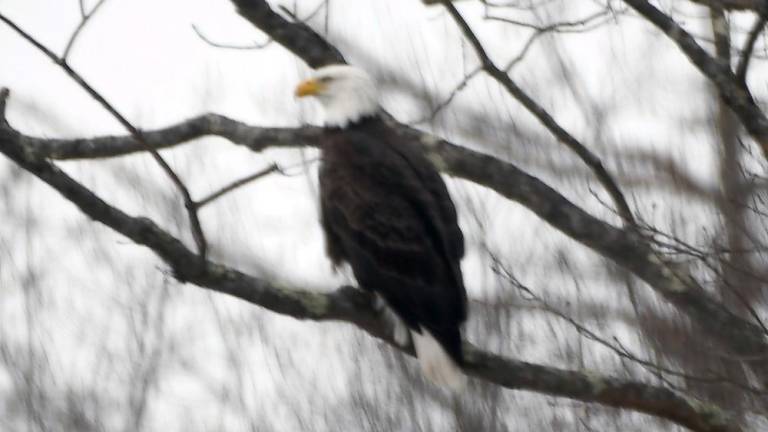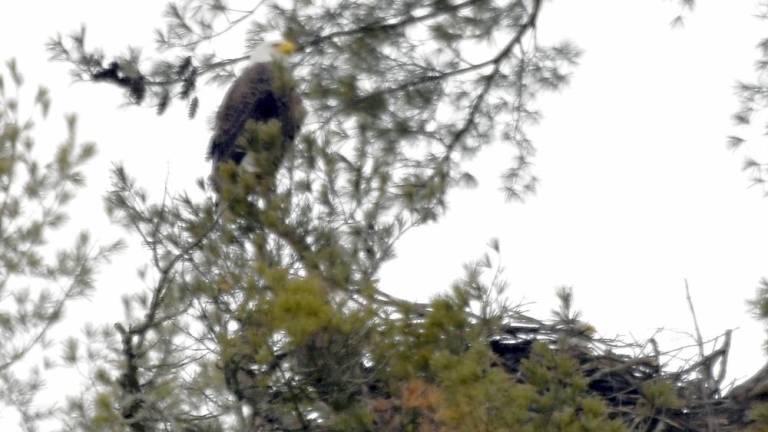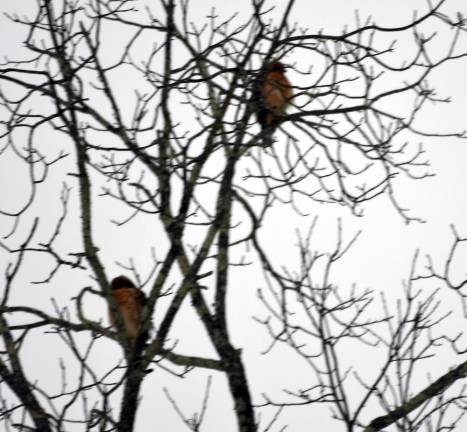Report on the Feb. 14 Search for Eagles
Milford. The eagle observation data collected will be shared with the National Park Service, the Sussex County Bird Club, the Eagle Institute, Hawk Mountain Sanctuary, and the Hawk Migration Association of North America.



The season’s third Brandwein Field Trip Search for Eagles took place in the Delaware Valley on Feb. 14 from 8 a.m. to 3:30 p.m.
The temperature at the start was 19 degrees and at the finish 30 degrees. It was a cloud-covered gray day with 31 inches of snow on the ground; however, all roads were clear and navigable.
We began by watching feeder birds, including two red-shouldered hawks at the Pocono Environmental Education Center (PEEC), hairy woodpeckers, dark-eyed juncos, blue jays, and a pileated woodpecker, among others. Nine participants, wearing face coverings and social distancing, logged 141 miles in the Delaware Water Gap National Recreation Area and Upper Delaware Scenic River from PEEC to the Bushkill Access and the trip’s conclusion at the headwaters of the Lackawaxen River.
The search included seeing 35 species of birds: 21 bald eagles, 17 red-tailed hawks, 2 red-shouldered hawks, 1 Coopers hawk, and a common raven.
Our first bald eagle sighted was a perched juvenile bird that took flight in the fields near Tom’s Creek. No bald eagle at Bushkill Access. No eagles at the Dingmans Access; however, the toll collector said he saw three bald eagles that morning upriver from the bridge, two adult eagles on the ice eating a fish.
A light phase rough-legged hawk flew northward as we chatted. No eagles were at Dingmans cemetery or Route 209 mile marker 16 nest. An adult bald eagle was perched on the shale pit nest near mile marker 17 with another eagle in the nest.
No luck at Milford Beach. Three juvenile bald eagles were perched on the New Jersey side that we observed from the river road.
In Milford, we checked the nest near the Charles Peirce House and behind the Delaware Valley High School. No eagles present.
We added a pit stop at the Pennsylvania Welcome Center. Driving through Matamoras we spotted a perched Coopers hawk.
We checked an active nestvat the Laurel Grove Cemetery overlook above the tristate monument. No eagle present; however, we added a common redpoll and Eastern bluebirds.
The Eddy Farm Resort overlook was quiet; no new species added.
By noon we were at the Hawks Nest historical marker. Checked the whitewash on the cliff, no peregrine falcon. We watched five bald eagles soaring above. One was a sub-adult, the others were four juveniles. From the Indian Head Canoe livery station we located the nest on the Pennsylvania side of the river. We spotted an adult bald eagle very close to us on the Pennsylvania side. I was able to capture an image of the perched eagle. At Pond Eddy on the Pennsylvania side we spotted a perched adult bald eagle in a white pine. This location is where in past there was an active bald eagle’s nest. The nest is no longer there; however, this is an area that bald eagles frequent. High above in a white pine, one where we frequently see eagles, an adult bald eagle was perched.
We continued to the Mongaup Falls Observation Blind, where volunteers pointed us to a perched adult bald eagle. Common mergansers and a raft of black ducks were on the water. We checked the nest along Plank Road; no eagles present.
A bald eagle flew above the Rio Reservoir Dam as we crossed it.
We returned to the Delaware and traveled upriver to the Barryville-Shahola nest site. No eagles. An adult eagle was perched near the river access just north of Barryville. By the time we reached the confluence of the Lackawaxen and the Delaware where and adult bald eagle was perched, we had observed 18 bald eagles. The adult eagle flew from the Lackawaxen and perched in New York near the confluence of the two rivers as we waited.
We added three adult bald eagles along the Lackawaxen. None were at either of the two nests we are monitoring. The first was at Church Road, the second at Evangelder Road, and the third at Appert Road.
We concluded our field trip at 3 p.m.
Future Searches for Eagles:
Future searches will be held on the following Sundays: March 7 and 14.
Weather permitting, meet at 8 a.m. at the PEEC parking lot (538 Emery Road, Dingmans Ferry, Pa.), or at 10 a.m. at the north entrance to the Delaware Water Gap National Recreation Area entrance, Route 209 south mile marker 20, Milford, Pa. The search will conclude along the Lackawaxen River at approximately 4 p.m.
Dress warmly, and bring binoculars, field guides, and a lunch. Face coverings and social distancing are required.
To participate, email jackpeec@aol.com or call 845-325-0536, and indicate which field trips you will be attending. There is no charge.
An eagle identification field guide, and Search for Eagles activities publication will be provided by the Brandwein Institute.
Editor’s note: Jack Padalino, who leads the Search for Eagles, is president emeritus of the Pocono Environmental Education Center, a partner with the National Park Service.